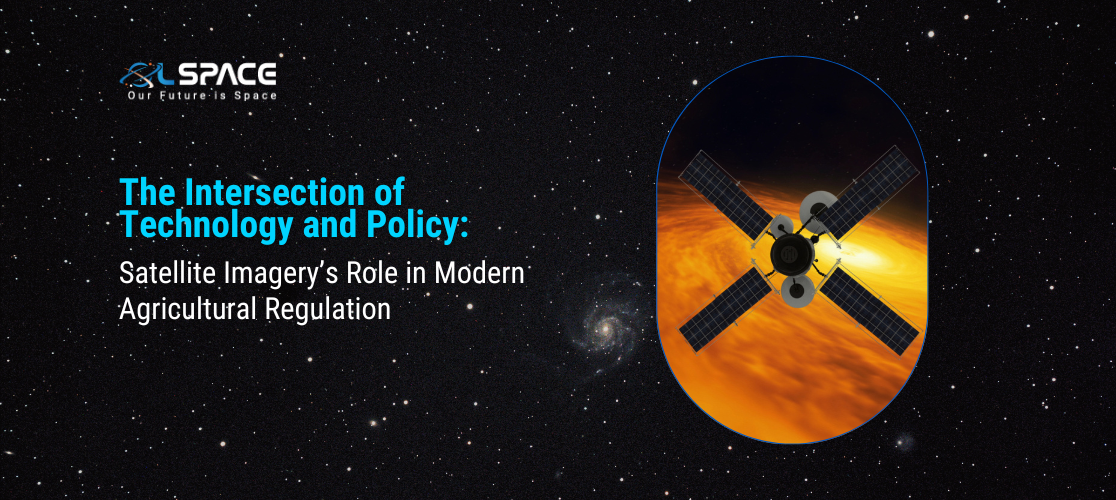30 July 2024
The Intersection of Technology and Policy: Satellite Imagery’s Role in Modern Agricultural Regulation

In the realm of agricultural regulation, the integration of cutting-edge technology has revolutionided monitoring, compliance, and policy enforcement. Satellite imagery, in particular, has emerged as a powerful tool, enabling regulators and farmers alike to manage and oversee agricultural practices with unprecedented accuracy and efficiency. This blog explores the role of satellite imagery in modern agricultural regulation, highlighting how it is shaping policies, enhancing sustainability, and ensuring compliance with environmental standards.
The Role of Satellite Imagery in Agriculture
Satellite imagery provides comprehensive, real-time data on land use, crop health, soil conditions, and more. This technology supports a range of applications in agricultural regulation, from monitoring land use changes to detecting illegal activities and assessing environmental impact. Here’s how satellite imagery is transforming the landscape of agricultural regulation:
1. Monitoring Land Use and Crop Health
Satellite imagery enables detailed monitoring of land use changes and crop health across vast areas.
High-resolution images and multispectral sensors provide data on crop growth stages, pest infestations, and soil moisture levels, allowing for timely interventions and better resource management.
Applications:
Tracking land use changes to prevent illegal deforestation and land conversion.
Monitoring crop health and stress indicators to optimise farming practices and enhance yield predictions.
2. Enforcing Compliance with Environmental Regulations
Satellite imagery aids in enforcing environmental regulations by providing objective, scalable data.
This technology helps authorities monitor compliance with land use regulations, conservation easements, and sustainable farming practices, reducing the incidence of illegal activities such as unauthorised land clearing and water pollution.
Applications:
Detecting unauthorised land clearing and deforestation activities.
Monitoring water bodies for pollution levels and compliance with water quality standards.
3. Supporting Sustainable Farming Practices
Sustainability is a core focus of modern agricultural policies. Satellite imagery supports sustainable farming by enabling precise monitoring of soil health, irrigation practices, and pesticide usage. This data helps farmers adopt best practices, reduce resource wastage, and enhance soil fertility and crop resilience.
Applications:
Assessing soil health and recommending targeted soil management practices.
Monitoring irrigation patterns to promote water-use efficiency and reduce wastage.
Real-World Applications
1. Precision Agriculture
Precision agriculture leverages satellite imagery and GIS technology to enhance farming efficiency and productivity. By analysing satellite data, farmers can implement precise planting, fertilisation, and irrigation practices, reducing costs and minimising environmental impact.
Key Technologies:GIS mapping, NDVI (Normalised Difference
Vegetation Index), and drone imagery.
Impact:Improved crop yields, reduced chemical usage, and optimised resource management.
2. Forest Monitoring and Conservation
Satellite imagery is crucial for monitoring forest cover and biodiversity. It helps track deforestation rates, assess forest health, and support conservation efforts by providing data on forest cover changes, illegal logging activities, and habitat fragmentation.
Key Technologies:/b> LIDAR (Light Detection and Ranging), multispectral imaging, and SAR (Synthetic Aperture Radar).
Impact: Enhanced forest conservation strategies, better enforcement of anti-logging regulations, and support for biodiversity preservation.
3. Disaster Response and Risk Management
In the face of natural disasters such as floods, droughts, and wildfires, satellite imagery plays a vital role in disaster response and risk management. It provides real-time data for damage assessment, emergency response planning, and recovery monitoring, aiding in faster and more effective disaster management.
Applications:
Monitoring drought conditions and assessing crop damage.
Mapping flood extents and assessing infrastructure damage post-disaster.
Enhancing Policy Making with Satellite Data
1. Data-Driven Policy Development
Satellite imagery provides policymakers with robust data to develop informed, evidence-based agricultural policies. By analysing trends and patterns from satellite data, governments can design policies that promote sustainable agriculture, enhance food security, and protect natural resources.
Applications:
Using satellite data to set targets for reducing agricultural emissions and enhancing carbon sequestration.
Developing policies for sustainable land use and promoting agroecological practices.
2. Transparency and Accountability
Satellite imagery enhances transparency and accountability in agricultural practices. It allows stakeholders, including governments, NGOs, and the public, to monitor agricultural activities, ensuring compliance with regulations and fostering trust in the regulatory process.
Applications:
Publicly accessible dashboards and maps showing land use changes and compliance status. Enabling community-based monitoring and participation in conservation efforts.Challenges and Future Directions
1. Data Accessibility and Integration
One of the key challenges is ensuring that satellite data is accessible and usable for all stakeholders, including smallholder farmers. Efforts are needed to develop user-friendly platforms and integrate satellite data with ground-based observations and local knowledge.
2. Cost and Technological Barriers
The high cost of satellite imaging technology and data processing remains a barrier for widespread adoption. Innovations in satellite technology, data sharing initiatives, and public-private partnerships are essential to overcome these challenges.
3. Advancing Analytical Capabilities
Advancing analytical tools and machine learning algorithms is crucial for extracting actionable insights from satellite data. Continued research and development in AI and remote sensing technology will enhance the accuracy and utility of satellite-based monitoring systems.
Conclusion
Satellite imagery is at the forefront of transforming agricultural regulation, offering unprecedented capabilities for monitoring, compliance, and policy-making. By harnessing the power of satellite technology, we can enhance sustainability, protect natural resources, and ensure a more resilient agricultural sector. As we move forward, continued innovation, collaboration, and investment in satellite technology will be key to unlocking its full potential in shaping a sustainable and prosperous future for agriculture.
